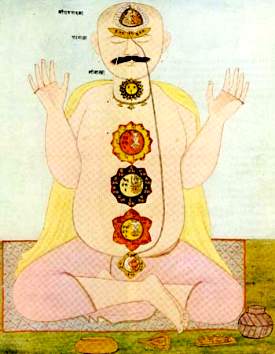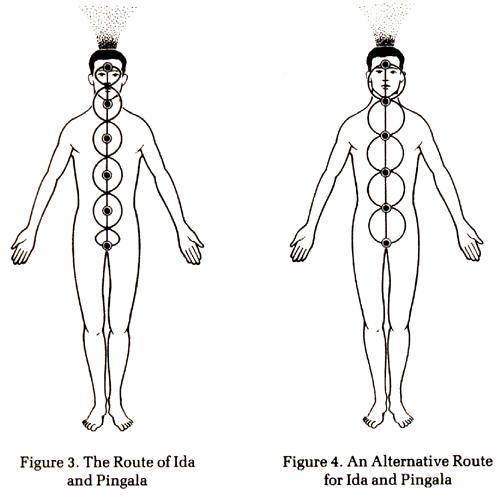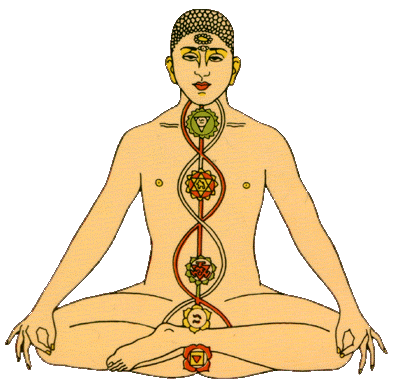The Shakta Theory of Chakras
 |
THE SEVEN CHAKRAS OF LIFE
Developed Shakta doctrine postulates seven chakras (see drawing above). These are called the Muladhara or "Root Support" at the base of the spine with four "petals", the Swadhishthana or "Own Abode" at the root of the genitals with six, the Manipura or "Fullness of Jewels" at the level of the navel with ten "petals", the Anahata or "Unstruck Melody" at the heart-centre with twelve, the Vishuddha or "Complete Purity" at the throat with sixteen, and finally the Ajna or "Guru's Command" at the brow with two "petals". The Crown centre, the Sahasrara-Padma or "Thousand Petalled-Lotus", located at the very top of the head, is technically speaking not a chakra at all, but the summation of all the chakras.
The Seven Chakras strung along the Central or "Sushumna" channel.
The chakras are strung along the central or Sushumna channel (usually located at the spine). In the lowest chakra, the Muladhara, at the base of the spine, there lies the kundalini-shakti, the latent consciousness-energy, the microcosm of the cosmic creative shakti. When this is aroused, it can be made to ascend the sushumna, either ac-tivating or dissolving (depending on the yogic tradition) each chakra in turn, until it reaches the highest or crown chakra, the Sahasrara, where dwells the Godhead or Supreme Shiva (Paramashiva). As the Kundalini-Shakti unites with Paramashiva, the original transcendent equilibrium is restored, and the yogi returns to the state of oneness with the Absolute.
The chakras are described as stations or centres of pure consciousness (chaitanya) and consciousness-power. They are focal points of meditation; iconographic structures within the occult or "subtle body".
Apart from the Sahasrara, each chakra is described by means of a whole lot of symbolic associations or correspondences. Building upon the initial later Upanishads speculation, each chakra, as well as having a specific position in the physical body, element, mantra, and deity, also has a particular number of "petals", each associated with one of the letters of the Sanskrit alphabet, a corresponding colour, shape, animal, plane of existence, sense-organ, mantric sound, and so on. A table giving some of the main associations.
A Fantastic Introduction to the Chakras - a short but very useful account - recommended
In addition to the seven major chakras arranged along the spine there are also chakras in the hands, feet, genitals, and so on. Also in addition to the seven major chakras, there are also a number of other chakras along the spine which are sometimes referred to. In his exhaustively detailed and definitive work on the chakras according to the traditional Indian understanding, Layayoga - an Advanced Method of Concentration, Shyam Sundar Goswami, citing numerous references, describes thirteen chakras altogether; the seven standard chakras there are six minor ones. The following lists the chakras according to the 13-chakra model.
| Chakra | Position | Petals | Tattwa | Element |
| Sahasrara | above head | 1000 | transcendent | transcendent spirit |
| Guru | above head | 12 | ||
| Nirvana | crown | 100 | origin of mind | mind |
| Indu | forehead | 16 | buddhi | |
| Manas | forehead | 6 | chitta | |
| Ajna | brow | 2 | manas | |
| Talu/Lalana | roof of mouth | 12 or 64 | n/a | |
| Vishuddha | throat | 16 | space | elements |
| Anahata | heart | 12 | air | |
| Hrit | heart | 8 | n/a | |
| Manipura | navel | 10 | fire | |
| Svadhisthana | genitals | 6 | water | |
| Muladhara | base of spine | 4 | earth |
Reference is also made in all Tantric texts to the nadis or channels of vital-force (prana). According to the traditional Tantric teachings, the seven chakras are strung like pearls or jewels along the brilliant thin thread of the sushumna nadi, which is the primary nadi in the body.
 |
On either side of the sushumna are the two main secondary nadis:
- the white moon-like ida on the left, containing descending vitality (apana),
- the red sun-like pingala on the right, containing ascending vitality (prana in the narrow sense of the term).
The tantric yogi aims to direct the subtle airs from these two primary side channels into the central sushumna nadi, and so activate the latent Kundalini energy. This then ascends through each of the chakras in turn, and when it reaches the top of the head, the yogi attains Liberation.
The understanding of the chakras and kundalini in the West derives largely from Sir John Woodroffe's book, "The Serpent Power", a very technical work, first published in 1919 under the psuedonym Arthur Avalon.
The first serious books on the chakras and Kundalini yoga to be published in the West, it is actually a translation of two sixteenth century Bengali texts and their commentaries, together with Woodroffe's own long and detailed introduction. Woodroffe's book - his own chapters cover Shakta metaphysics and cosmology, Patanjali Yoga, and Tantric practice, as well as the chakras themselves - is unfortunately very difficult for the beginner, but it served as the inspiration and chief reference text (usually without acknowledgment) for many Western occult-esoteric writers





0 komentar:
Posting Komentar